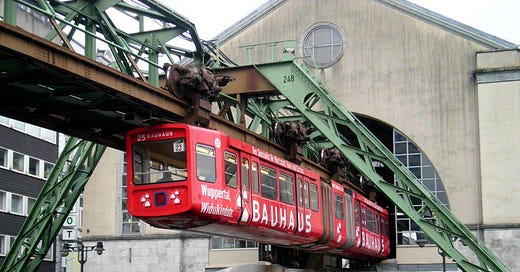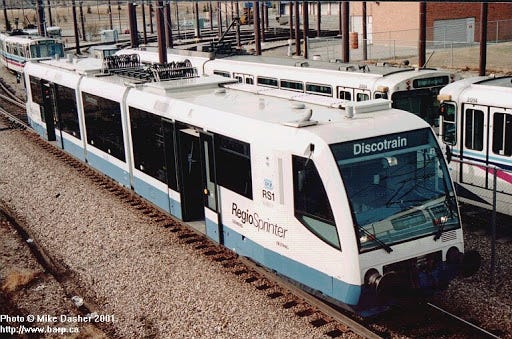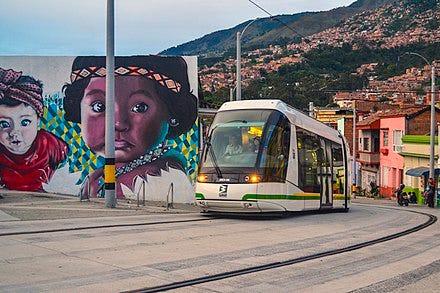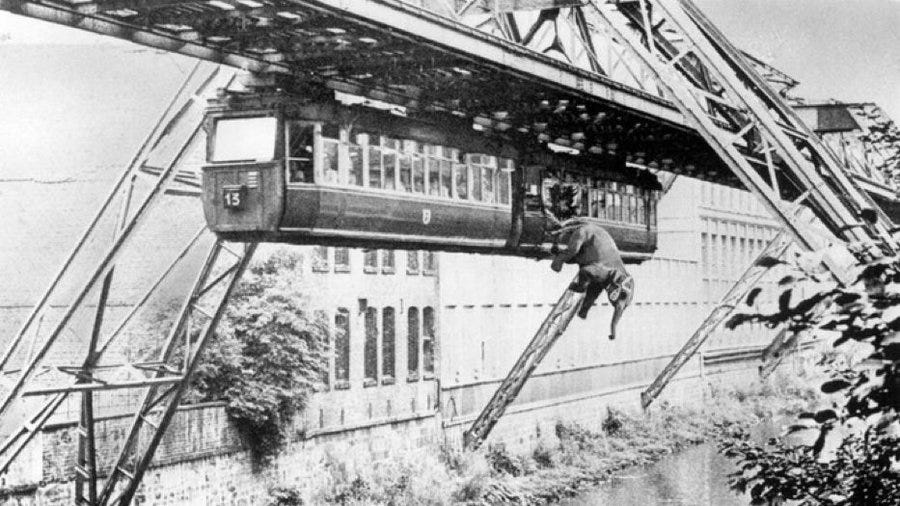Ever hear of the tram-train? It’s a system that lets lightweight trains travel quickly between cities, but also operate on city streets like trams. There’s one in Czechia, and another called the RegioSprinter, which is currently operating in Zwickau, Germany. They even trialled the system in Calgary, Alberta, back in the mid-1990s. It ran on Canadian Pacific railway tracks, and carried about 800 people a day at a top speed of 120 km/h (75 mph). And it had an awesome name: the Discotrain. (Given the era, though, shouldn’t it have been the GrungeTrain?)
I love lateral thinking when it comes to transit. Lots of people get on my case when I mention offbeat transit solutions on social media, pointing out their impracticalities. (This often happens when I talk about rubber-tired trams, which follow single-track guideways on the streets, as they do in Clermont-Ferrand, France—a city that happens to be home of rubber-tire maker Michelin. Apparently these systems have their problems; but they’re also good at mounting steep grades, which is useful in the Colombian city of Medellín.)
But my default attitude is, hell, it’s better than building more parking and freeways. Which, of course, has been the non-Bizarro world’s default attitude for almost a century.
Here’s another one that I can’t resist: the métro of Charleroi, Belgium. Is it a tram? A light metro? Light rail transit? This concrete-happy rail network is one of the weirdest I've ever ridden. At one point, the train I was on started to go backwards, reversing out of the station, which apparently was part of its regular route. It’s in a city in Flanders’ rust-belt with a population of just 200,000, yet it has eight lines. Many stations seem to be in the middle of nowhere, but they are glorious, if you love Brutalism. (Which I admit is kind of growing on me as an architectural style, now that I know that water-stained concrete isn’t going to take over the entire world.) You can read more about this surreal system on the always informative London Reconnections site.
How about this one, which is on my bucket list—and definitely worthy of a few paragraphs in the sequel to Straphanger, if I ever get around to writing it. (Straphanger 2: No Transfers!) The Ascensore Castello d'Albertis, in Genoa, Italy, is a combination of a funicular and an elevator. A gondola in the elevator part descends, meeting the gondola in the funicular section; the two gondolas are then hooked together, completing the horizontal-vertical trip without passengers having to disembark. OK, I’m not describing it very well—but frankly, part of me doesn’t want to know how it works, until I actually get on the thing. Molto Willy Wonka!
No such list would be complete with the fantastic Wuppertaler Schwebebahn (suspension railway), which bursts out of buildings and runs over a river dangling from its inverted-V stanchions. (See above—and below.) It’s been running since 1901. Pina Bausch filmed herself dancing on it, and, in an ill-advised publicity stunt, a fully-grown elephant—who was clearly not named Dumbo—was brought aboard, before plunging trunk-first into the river. (Amazingly, she survived.)
And I’ll leave you with the Schweeb, a human-powered monorail at an amusement park in Aotearoa, aka New Zealand. Look, mate, I know as a scaleable solution, it’s not exactly practical. And it might not qualify as pookah transit. (Fair dinkum!) But it sure looks like fun…
If you’ve got any bizarro, non-automobile transit solutions from around the world—do tell! (I warn you though, as a collector of these things, I’m pretty hard to surprise.)
Hope you’re enjoying these dispatches! I’m still trying to decide how often I’ll write them, or whether I’ll continue at all. You can help keep me on the right track by becoming a paid subscriber.












I hope you continue! Enjoyed this one. Wondering if you have soundtrack pairing recommendations? What to listen to when on the hanging tram that bursts out of a building?